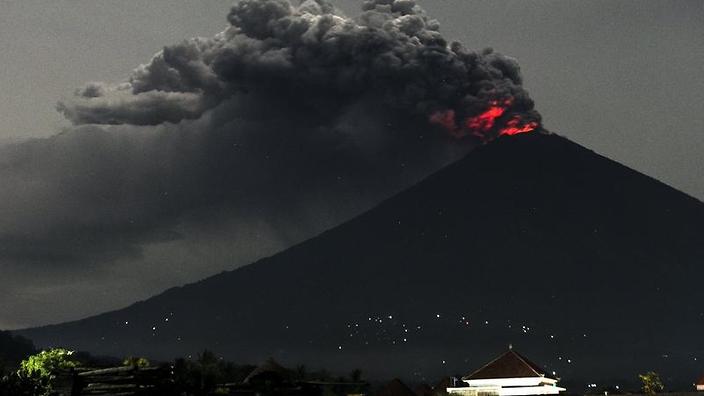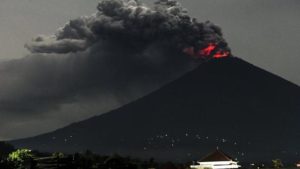
Volcanic ash from the Mount Agung volcano has closed Bali’s airport for a third day. (AAP).
Denpasar, MINA – Bali’s Mount Agung volcano is spewing ash 7,600 metres high and has closed the island’s international airport for a third day.
Authorities have told 100,000 people to leave an area extending 10 kilometres from Mount Agung as it belches grey and white ash plumes, the low clouds hanging over the volcano at times hued red from the lava welling in the crater.
The volcano’s last major eruption in 1963 killed about 1,100 people, but it’s unclear how bad the current eruption might get or how long it could last.
Officials have extended the closure of Bali’s international airport for another 24 hours due to concerns the thick volcanic ash could harm aircraft.
Also Read: Densus 88 Confirms Jakarta School Explosion Was Not Terror-Related
Airport spokesman Ari Ahsanurrohim said more than 440 flights were cancelled on Tuesday, affecting nearly 60,000 passengers. Without aircraft, getting in or out of Bali requires traveling hours by land and taking a boat to another island, enduring choppy seas in Bali’s rainy season.
The grounding of flights coincided with schoolies week in Australia, when an estimated 6000 teens were expected to flock to the island resort.
Many teens had expressed anxiety about being stuck in a foreign country, said a representative from Red Frogs, a support program for post-school partygoers.
“We’ve spoken to a number of school leavers who have concerns about not being able to get home,” locations leader Nickey Bright told AAP.
Also Read: Police Name Suspect in Jakarta High School Explosion
“It’s very different when you’re here by choice, and when you’re here and you feel like you can’t get home.”
Thermal anomaly at the crater
Experts say a larger, explosive eruption is possible or Agung could stay at its current level of activity for weeks.
“If it got much worse, it would be really hard to think of,” said Richard Arculus, a volcano expert at Australian National University.
Also Read: At World Peace Forum, Kalla Says ‘No One Wants to Be a Victim of War’
“There are many examples in history where you have this kind of seismic buildup – steam ejections of a little bit of ash, growing eruptions of ash to a full-scale stratosphere-reaching column of ash, which can presage a major volcanic event,” he said.
A NASA satellite detected a thermal anomaly at the crater, said senior Indonesian volcanologist Gede Swantika. That means a pathway from the storage chamber in the volcano’s crust has opened, giving magma easier access to the surface. (T/RS5/RS1)
Mi’raj Islamic News Agency (MINA)



























 Mina Indonesia
Mina Indonesia Mina Arabic
Mina Arabic